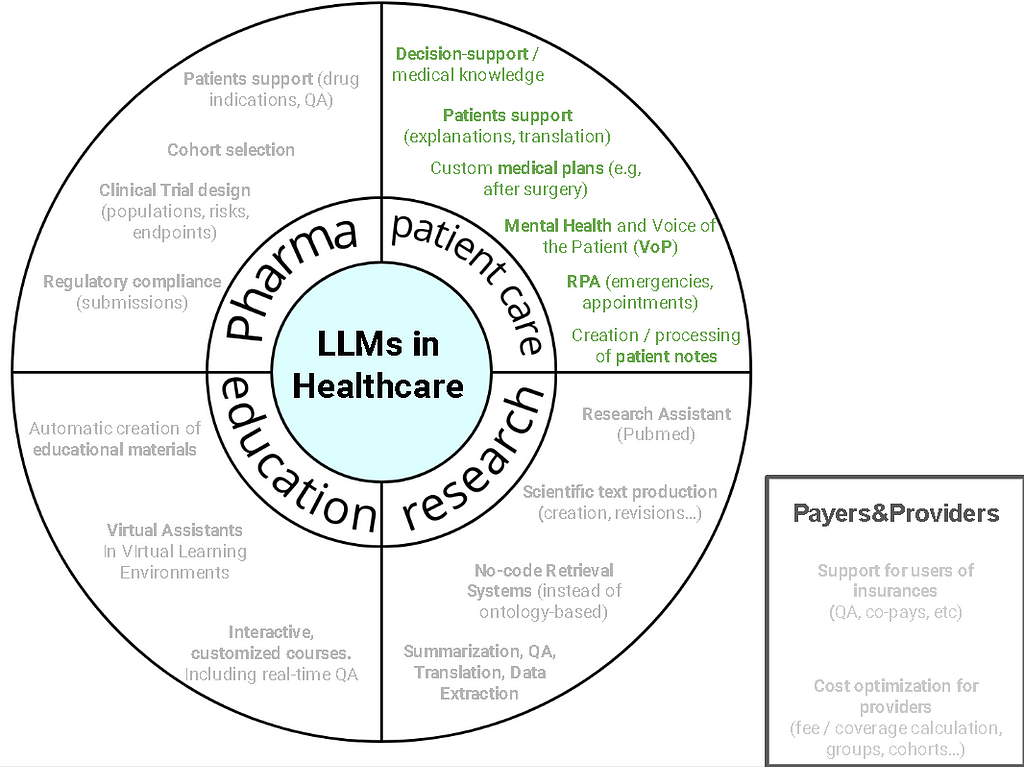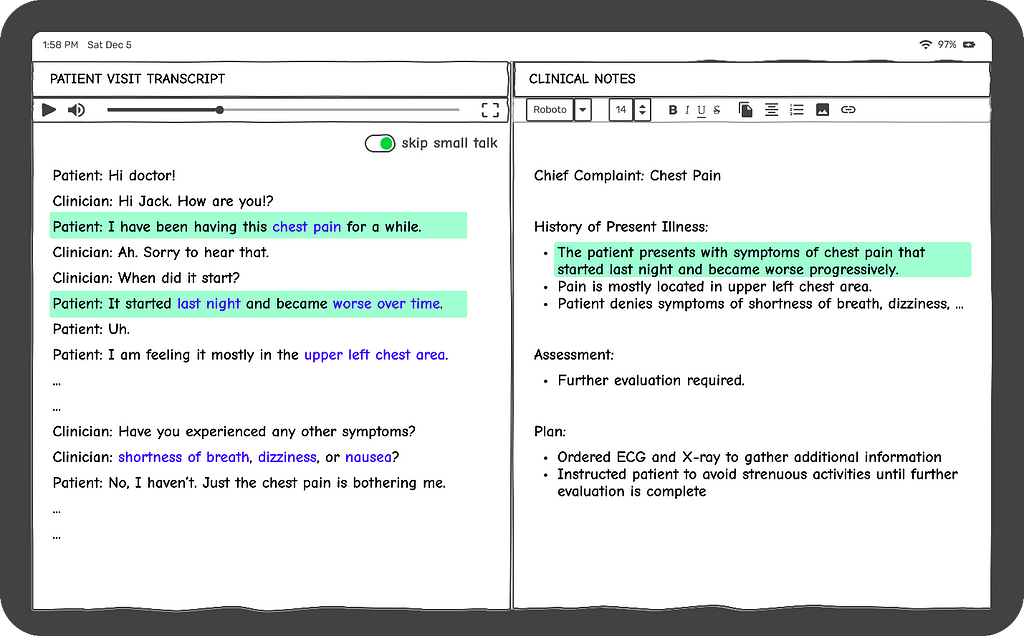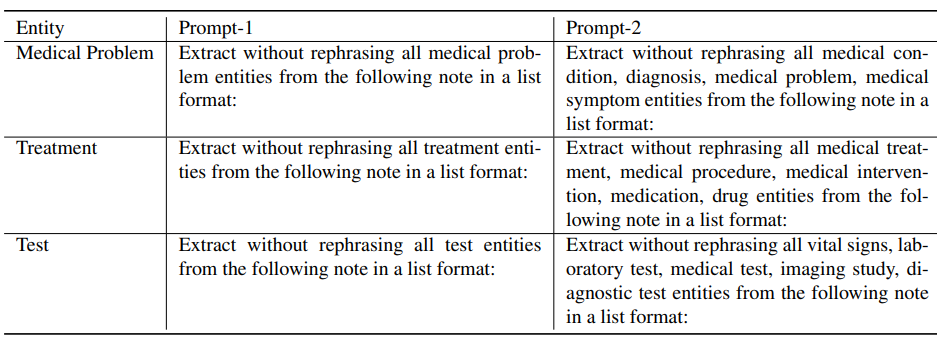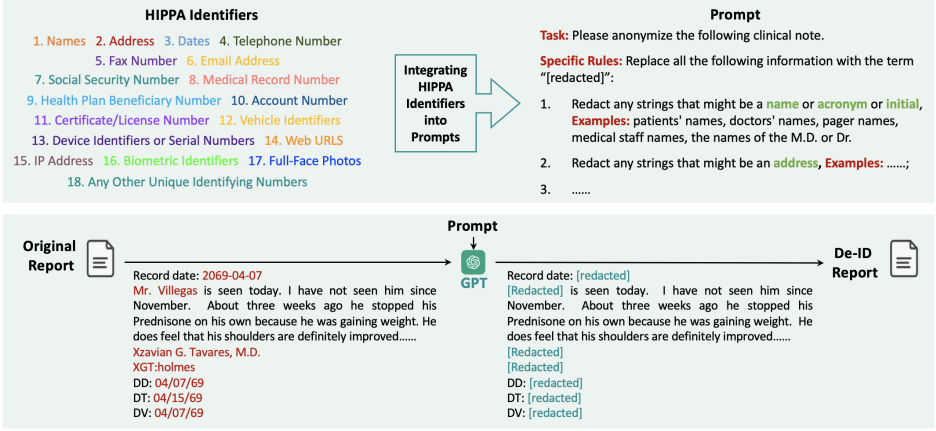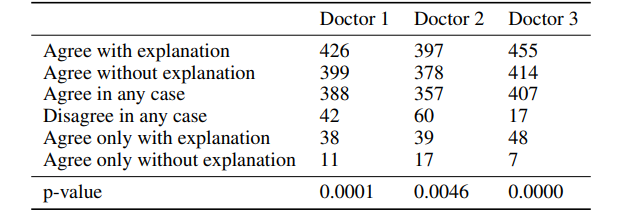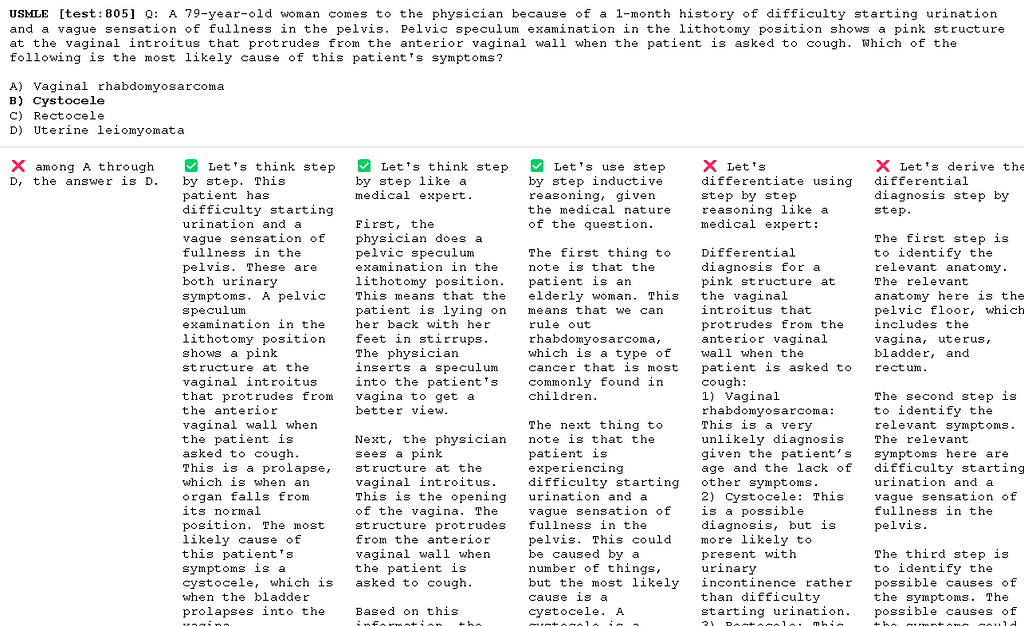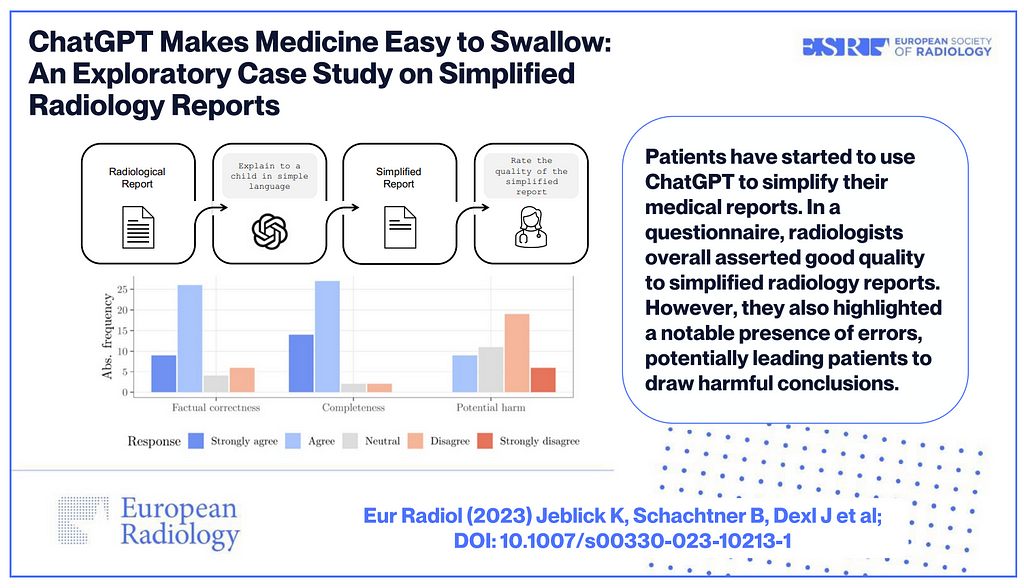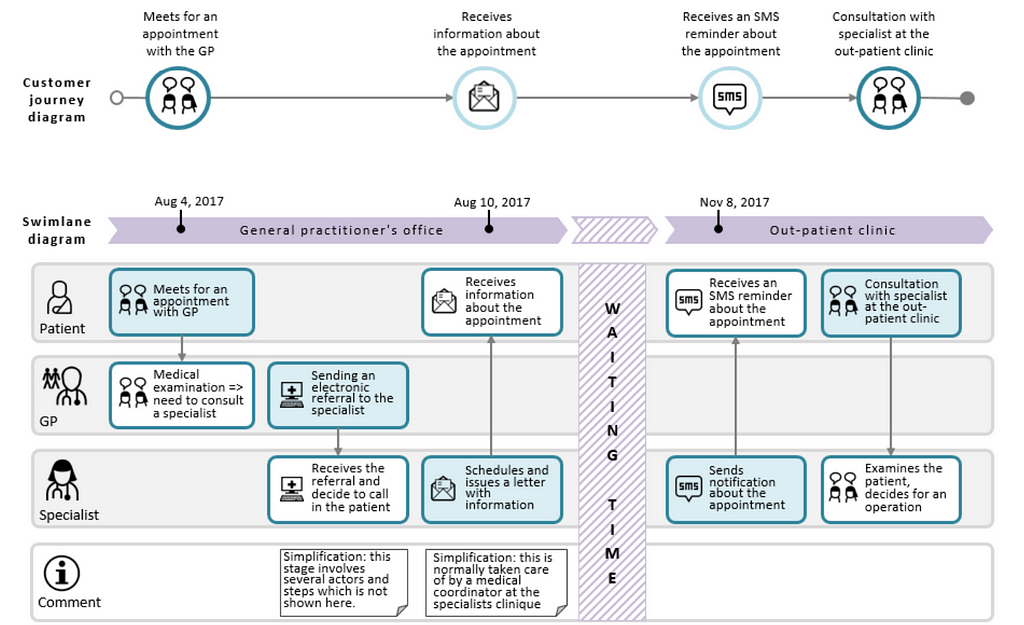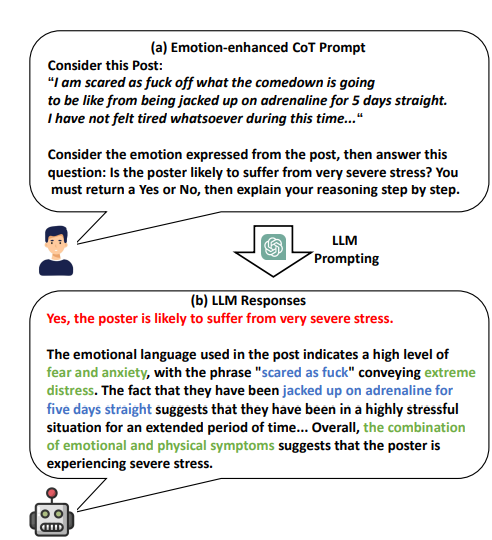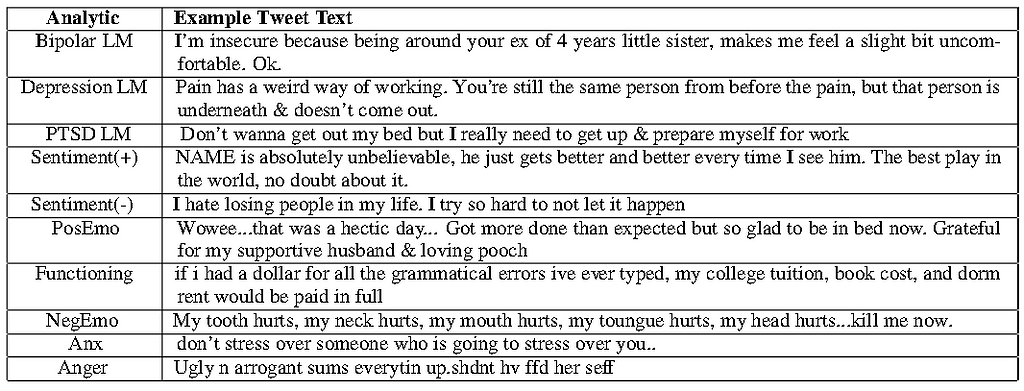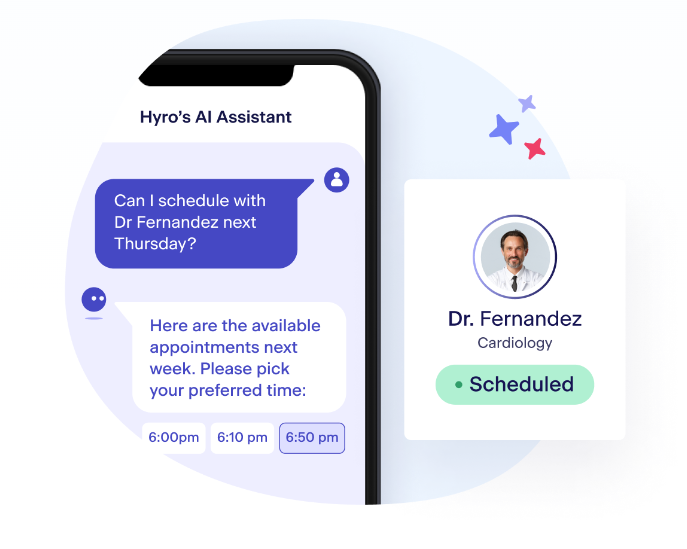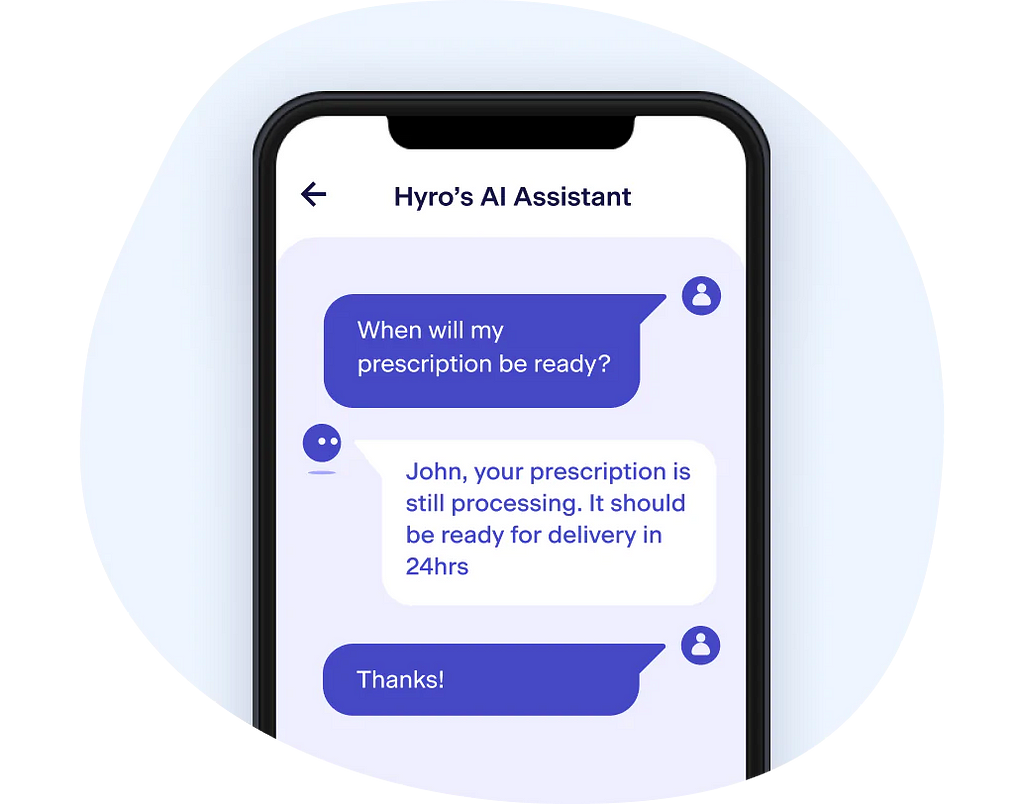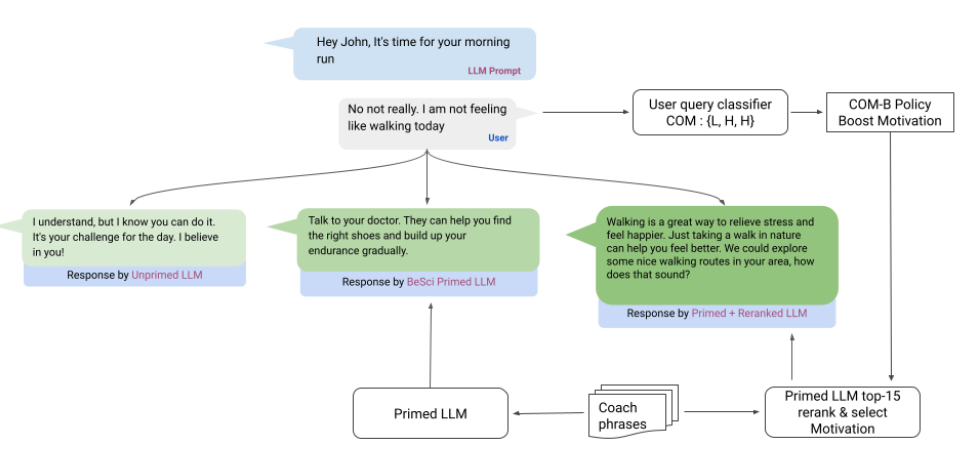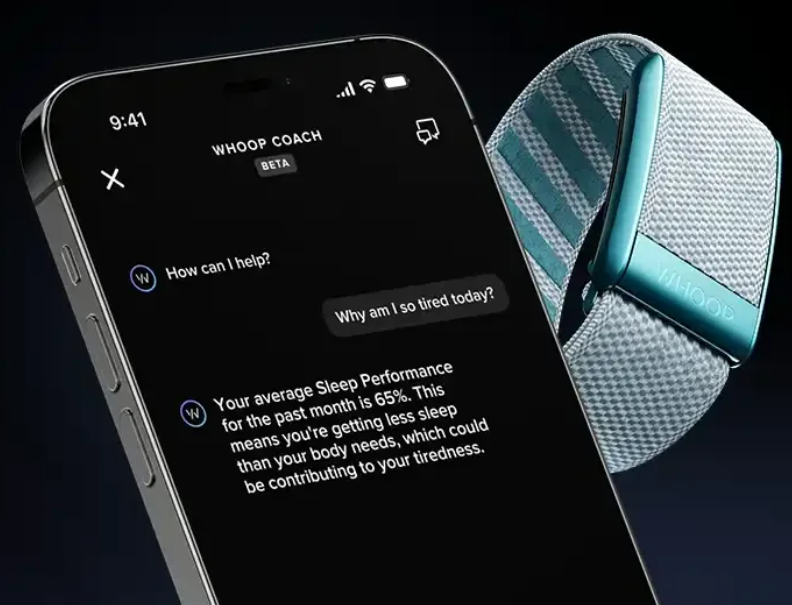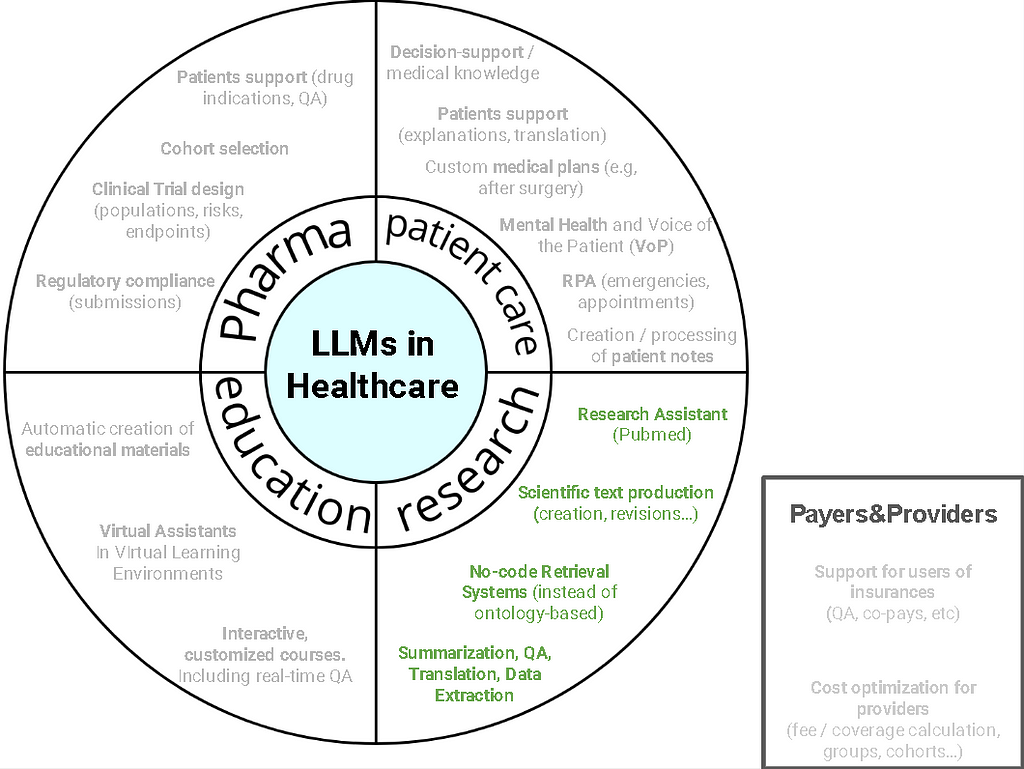Applications of LLMs in Patient Care
Categories:
LLMs in Healthcare: Patient Care
Introduction
In the dynamic landscape of healthcare, the integration of cutting-edge technologies is revolutionizing every facet of the industry. One such groundbreaking innovation is the application of Large Language Models (LLMs), which harness the power of natural language processing to reshape healthcare, medical and patient care, pharmaceutical practices, healthcare education, research endeavors, and the intricate relationships between payers and providers.
This article delves into the myriad ways LLMs are making waves in the healthcare sector, offering a comprehensive exploration of their transformative impact on Patient Notes Automatisation, Clinical Decision Systems, Patient Assistance and Communication Support, Mental Health, Personalized Health Plans and many other fields. Get ready and fasten up your seats, we are going to have a ride through the multifaceted applications of LLMs in shaping the future of healthcare!
Enhancing Patient Care through Large Language Models
In the realm of healthcare, effective human communication serves as a linchpin in patient care, influencing factors such as patient-caregiver relationships, satisfaction levels, and overall clinical outcomes. Clear interpretation of spoken language and written text is pivotal in facilitating communication among medical professionals regarding patient information, diagnostic procedures, and treatment implications. The quality of patient care is directly affected by the clarity of communication, and inefficient interaction among healthcare providers can also impose economic burdens on clinical institutions and healthcare systems.
LLMs emerge as transformative tools in elevating patient care through several primary avenues:
1. Processing intelligently Patient Notes.
LLMs can be valuable in working with millions of entries of patient notes in various ways, leveraging their natural language processing capabilities. Here are several ways LLMs can assist in handling and extracting insights from large volumes of patient notes.
Automatic creation of Patient Notes
By leveraging advanced both audio and textual natural language processing algorithms, healthcare professionals can seamlessly transcribe and document conversations with patients, ensuring accuracy and efficiency in note-taking. This not only streamlines the administrative burden on medical practitioners but also enhances the overall quality of patient care. NLP-powered solutions can capture nuanced details, medical terminology, and context, translating spoken words into comprehensive and organized notes. This innovation not only saves time but also empowers healthcare providers to focus more on patient engagement and personalized care, ultimately contributing to improved healthcare delivery.
Figure 1: AWS Healthscribe capturing the patient-clinician conversation, transforming it to a scribe and creating the clinical note (source)
Extraction of key information from Patient Notes
LLMs can be trained or fine-tuned to recognize and extract important entities such as patient names, dates, medical conditions, medications, and other relevant information from patient notes. This NLP task is called Named Entity Recognition (NER). Also, LLMs can help identify and extract temporal information, such as the timeline of events, treatment progress, and changes in the patient’s condition over time.This paper tested the capabilities of ChatGPT for extraction clinical entities as Medical Problem, Treatment and Test using two different prompts:
Figure 2: Prompts for Clinical Named Entity Recognition
LLMs can assist in tagging and categorizing patient notes based on their content, making it easier to organize and retrieve information when needed. This includes the sentiment expressed in patient notes, helping healthcare providers understand the emotional state of the patient and identifying potential areas of concern or improvement.
Summarization and anonymization
In addition, LLMs can generate concise and informative summaries of lengthy patient notes, making it easier for healthcare professionals to review and understand the key details without going through the entire document. If you are interested in knowing more about Clinical Patient Notes summarization, check this publication which also features Automatic Prompt Engineering, to chose which are the prompts which retrieve best summaries. They came up with the following:
Figure 3: Some auto-generated prompts to carry out Patient Notes summarization
And last, but not least, one of the most frequent use cases is the redaction / anonymization of Patient notes. When implementing LLMs for handling patient notes, it’s essential to consider data privacy and security regulations, as well as the need for proper validation and evaluation to ensure the model’s reliability in a healthcare setting. LLMs can be utilized to automatically redact or mask sensitive information in patient notes, helping to ensure compliance with privacy regulations.
There has been significant progress in using LLMs for anonymization purposes. This paper describes DeID-GPT, a new ChatGPT-4 based framework to de-identify documents for HIPAA compliance.
Figure 4: DeID-GPT framework
2. Helping in the Clinical Decision Support
LLMs, such as GPT-4, significantly contribute to Clinical Decision Support (CDS) by leveraging natural language processing. They analyze vast healthcare data, interpret electronic health records, and extract valuable insights. LLMs assist healthcare professionals by summarizing complex medical literature, staying updated on the latest research, and generating patient-specific recommendations. By bridging the gap between extensive medical knowledge and practical decision-making, LLMs enhance the accuracy and efficiency of CDS, ultimately improving patient outcomes and healthcare quality.
Support in the Clinical Decision Support
LLMs can assist healthcare professionals by providing relevant information and suggestions based on the content of patient notes, potentially aiding in the diagnostic process. This includes the identification of unusual or anomalous patterns in patient notes, helping healthcare providers detect potential issues or trends that may require further investigation;
There has been an experiment to measure LLMs reasoning and explaining capabilities of diagnoses. They found that LLM’s explanations augment the inter-doctor agreement, helping doctors to reach an agreement. You can find here:
Figure 5: Doctors’ agreement with explanations of Chat GPT about the diagnosis of patients
These are their conclusions:
From our findings, it is clear that LLMs:
- Are capable of producing high-quality explanations in most cases, further underscoring their potential in Clinical Decision Systems (CDDs).
- Generate explanations that can statistically significantly elevate doctor agreement rates with given diagnostic hypotheses, emphasizing their persuasive power.
- Can err in a range of 5% to 30%, often due to the model’s eagerness to align all symptoms with the current diagnostic hypothesis.
Medical Reasoning and Causal Inference
Medical reasoning tends to be closer to a causal inference due to the emphasis on understanding cause-and-effect relationships in healthcare, than to a traditional inference.
Although LLMs have been trained mainly to carry out traditional inference, there are several prompting approaches for Medical Reasoning and Causal Inference which sometimes prove helpful. This resource collects several experiments about Chain-of-Thought (CoT) prompting technique and how the answers to different medical exam questions differ depending on them:
Figure 6: Different Chain-of-Thought prompts to try to mimic Medical Reasoning and improve the results on different medical exams.
3. Patients Support
Language Models bring a revolutionary approach to healthcare assistance. By employing advanced natural language processing, LLM enables personalized and efficient interactions, offering patients a seamless and empathetic support system. From answering queries to providing relevant information, LLM enhances patient experiences, fostering a more connected and informed healthcare journey. These are some of the advantages of LLM for a patient-centric approach that transcends traditional support methods:
Communication Assistance
LLMs prove invaluable in bridging language gaps, facilitating communication between healthcare providers and patients through simplification, translation to other languages or to specific audiences and summarization of complex medical information. Also, LLMs can serve as natural language interfaces, allowing patients to ask questions and retrieve answers based on their clinical situation, using natural language.
All of this helps healthcare professionals overcome language barriers and automatically adapt their wording and style tailoring explanations to different audiences, as seen in their explanations of complex medical concepts for various age groups or different educational backgrounds.
One of the experiments in the field of audience-adapted texts was carried out by the European Society of Radiology, for simplifying radiology reports. The report can be found here:
Figure 7: Adapting Radiology Reports to different audiences
However, they found a human-in-the-loop approach is still necessary, as some errors were produced by the LLM:
Figure 8: Some errors when adapting the text to other audiences
4.Mental health and Voice of the Patient
In the ever-evolving landscape of mental health, understanding the intricate emotions and experiences of patients becomes paramount. Leveraging the power of Language Models, life science companies are delving into a better understanding of Patient Journeys and approaching a more Voice of the Patient-focused methodology to revolutionize the way we comprehend health journeys.
However, assessing Mental Health from Patient Journeys is a challenging task, given how complex communications between healthcare professionals and patients happen.
Unveiling Mental Health from a Patient Journey
The patient journey is not just a chronological sequence of events; it’s a complex tapestry of emotions, challenges, and triumphs. By employing LLMs, particularly for the analysis of the Voice of the Patient, life science companies are gaining unprecedented insights into the emotional states of patients at different stages of their disease journey.
Understanding this emotional tapestry serves as a cornerstone for designing patient-focused products and services. It goes beyond merely addressing symptoms; it involves creating a holistic approach that considers the emotional well-being of patients. By deciphering sentiments, companies can tailor treatment plans, bridge care gaps, and address unmet needs, ultimately leading to improved patient outcomes and experiences. However, the communication channels are diverse and a patient may end up talking to many different professionals, difficulting the detection of any issues including mental or behavioral health ones.
Figure 8: Patient journeys are complex and happen in many communication channels. Using LLMs to track and process the whole journey is one of the most promising approaches in
Interpreting Mental Health in Clinical Notes
This recent publication from the University of Manchester and Helsinki shows the level of performance of Chat GPT when used to interpret mental health issues in texts.
Figure 9: Chat GPT interpreting emotions
They describe a pipeline for obtaining and evaluating the level of accuracy of the LLM-generated explanations for mental health analysis in terms of fluency, reliability, and completeness. As with other described use cases, they found that “ChatGPT achieves the best performance among all examined LLMs, although it still significantly underperforms advanced supervised methods, highlighting the challenges of emotion-related subjective tasks”
Social Network interactions as part of the Patient Journey
But patient journeys are not only complex and extended in time — they are also multiformat and multimodal, being social networks an important source of information about the patient’s mental health. These messages are usually short and also have their own specific writing rules.
These short messages often encapsulate raw and unfiltered emotions. NLP models, by efficiently analyzing these succinct expressions, provide a real-time window into the emotional states of individuals, facilitating quicker response times and more targeted interventions.
Figure 10: Analyzing sentiments in short messages (Tweets)
In the realm of mental health, where communication is often nuanced and complex, short messages play a crucial role. This is where NLP comes into play, specifically through three key modules:
- Voice of the Patients Profiling: Whether it’s tweets, WhatsApp messages, or direct messages, this profiling provides a comprehensive understanding of the language patients use to express their thoughts and emotions.
- Stressors Classification: Identifying the sources of stress is pivotal in creating targeted interventions. NLP assists in classifying these stressors, offering a nuanced understanding of the factors contributing to the emotional state of patients.
- Emotion Classification: Beyond just identifying stressors, NLP goes a step further to classify the type of emotions expressed by patients. This nuanced categorization enables life science companies to pinpoint emotional inflection points and behavioral triggers that might otherwise remain hidden.
In the field of Patient’s Behavioral and Mental Health, there is a publication describing 3 approaches to include LLM in psychotherapy.
Figure 11: LLMs for assistance in Mental and Behavioral Health
5. Process automation
In the rapidly evolving landscape of healthcare, the integration of cutting-edge technologies is crucial for enhancing efficiency and improving patient outcomes. One such groundbreaking technology is the use of Language Models (LLMs) in conjunction with Robotic Process Automation (RPA). This powerful combination is proving to be instrumental in streamlining various healthcare processes, leading to increased productivity and optimized resource utilization.
Automating healthcare scheduling tasks
By harnessing the capabilities of virtual assistants powered by LLMs, healthcare providers can revolutionize tasks such as asking for an appointment with a doctor, a nurse or just contacting the patient; routing calls to different departments depending on the needs; providing prescription support for patients in need of new prescriptions or just to renew them, etc. These virtual assistants leverage natural language processing and understanding, enabling them to interact seamlessly with both patients and healthcare professionals.
Figure 12: Hyro AI Assistant offers a full scheduling management tool powered by LLM
Alleviating administrative burdens
Internal, administrative burdens can be alleviated as well. Tasks as requests refill, status updates, creation of emails, reports and any kind of internal process can be automated using LLMs. This, in turn, allows healthcare professionals to focus more on patient care and reduces the strain on the overall healthcare system.
Intelligent resource allocation
One of the primary advantages of employing LLMs in healthcare is the ability to intelligently evaluate resource allocation for emergency rooms, for bed availability, etc. Virtual assistants equipped with advanced language models can analyze patient data and symptoms, helping in the early identification of critical situations. This proactive approach not only reduces the burden on emergency services but also facilitates more efficient allocation of healthcare professionals. In regions facing shortages of medical professionals or facilities, these automated systems can play a pivotal role in decreasing the demand for doctors while optimizing the resources allocation plan.
Very related to resource allocation**,** one of the main tasks we have seen hospitals implement is **hospital readmission prediction.** By analyzing extensive patient records, identifying patterns and risk factors using natural language processing. They consider diverse data sources, such as electronic health records and social determinants of health, providing a comprehensive patient overview. This assists healthcare professionals in identifying high-risk patients, enabling personalized care plans and interventions, ultimately improving outcomes and reducing hospital readmissions.
Take a look at the Health system-scale language models are all-purpose prediction engines paper, which studies the predictive power of models including resource allocation for emergency rooms and readmission prediction, described above:
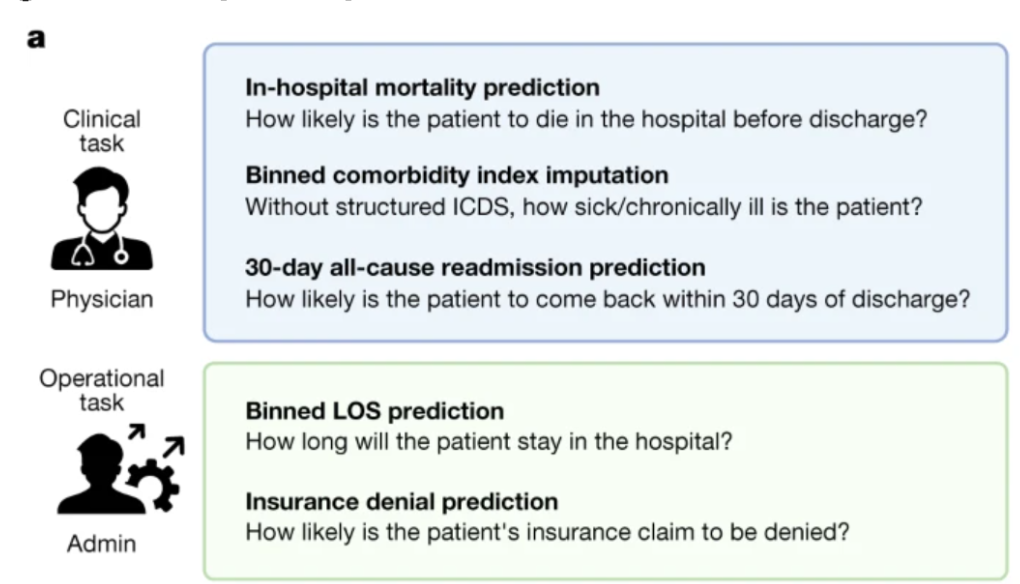
Figure 13: LLMs for different prediction models in hospitals
6. Personalized Health Plans and Coaching
In the ever-evolving landscape of healthcare, Language Models (LLMs) are proving to be invaluable tools for tailoring medical plans to individual patient needs. This adaptability is particularly transformative when designing post-surgery and mental health plans, where personalized care can significantly impact outcomes.
Access to customized plans
One of the main benefits of personalized healthcare is the ability to access customized plans any time without paying a visit to the doctor. LLMs excel in analyzing extensive datasets, including those related to specific surgical procedures, patient recovery paths, and potential complications. By processing this wealth of information, these models can generate customized post-surgery plans. These plans take into account patient demographics, health history, and potential risk factors, ensuring a recovery process optimized for each individual. The result is a reduction in complications and an expedited return to normalcy.
Another very requested field is mental health plans. Through the analysis of patient histories, including past mental health challenges and responses to various interventions, LLMs contribute to crafting personalized mental health plans. These plans may include tailored therapy recommendations, coping strategies, and even adjustments to medication, all designed to address the unique needs and sensitivities of each patient.
There have been several experiments using LLMs and a sort of a RAG-empowered LLM, where previously created coaching data was used for the customized messages. You can find it in this publication.
Figure 14: Three different approaches (using just an LLM or empowered it with retrieved information from an in-house database) to custom health personalization.
We found several companies who claim the usage of LLM for custom medical plans empowered by LLMs: InteliHealth, for custom health plans for individuals with obesity, and Babylon, with generic health customized programs. However, Apple requires a special mention as one of the creators of personal e-health devices, such as smartwatches.
Apple just released a collaboration with LumiHealth, specialized in custom health apps, for empowering their watches with AI, including LLMs. But the only current application of LLMs we could found working at present was Whoop Coach, a coach for Whoop smart watches powered by OpenAI.
Figure 15: Whoop connects to the data your watch collects and creates specialized plans and suggestions for you using ChatGPT
Conclusion
In conclusion, the diverse applications of Language Models (LLMs) in the healthcare sector, as explored in this article, showcase a revolutionary wave of transformation. From automating patient notes to powering clinical decision systems, providing patient assistance and communication support, addressing mental health concerns, and tailoring personalized health plans, LLMs are at the forefront of reshaping various facets of healthcare. As we embark on a journey through these multifaceted applications, it becomes evident that LLMs are not just tools but catalysts propelling the healthcare industry into a future where innovation, efficiency, and patient-centric care converge for a more holistic and advanced healthcare experience.
Need help?
If you want us to guide you through the implementation of LLMs-based engines for the Patient Care industry, our experienced team of NLP engineers with background in healthcare will be happy to help. Just reach out to us at hi@mantisnlp.com
Applications of LLMs in Patient Care was originally published in MantisNLP on Medium, where people are continuing the conversation by highlighting and responding to this story.

